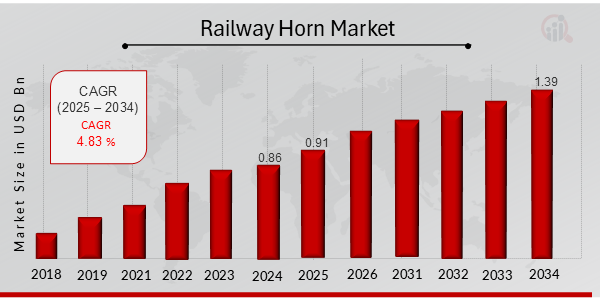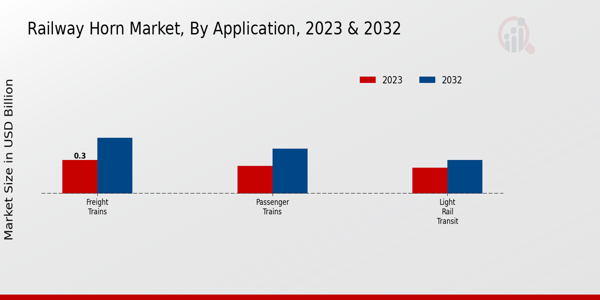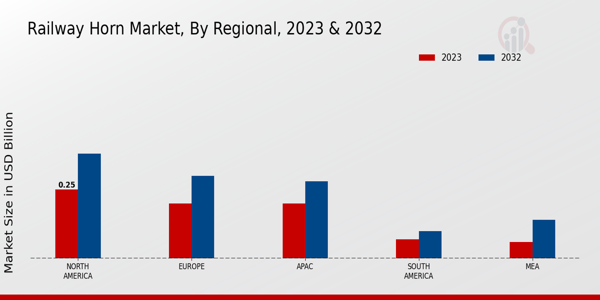Railway Horn Market Overview:
As per MRFR analysis, the Railway Horn Market Size was estimated at 0.86 (USD Billion) in 2024. The Railway Horn Market Industry is expected to grow from 0.91 (USD Billion) in 2025 to 1.39 (USD Billion) till 2034, at a CAGR (growth rate) is expected to be around 4.83% during the forecast period (2025 - 2034).
Key Railway Horn Market Trends Highlighted
The global railway horn market is experiencing significant growth driven by increased investments in rail infrastructure, modernization of existing networks, and rising safety regulations. The need for improved signalling systems and the demand for more reliable railway operations are key factors boosting market development.
The expansion of urban transit systems and freight services further emphasizes the importance of efficient alert systems in trains. Additionally, the push for sustainability in transportation is prompting manufacturers to innovate and develop environmentally friendly products, enhancing their appeal to railway operators.
Opportunities in the market include the adoption of advanced technologies such as smart sensors and electronic horn systems. As rail systems evolve, integrating innovative features such as noise reduction and adaptive sound technologies can create new revenue streams.
Rising urbanization and the consequent development of high-speed and urban rail projects represent a significant opportunity for market players. Additionally, emerging economies are increasingly focusing on enhancing railway systems, providing avenues for suppliers to penetrate new markets and expand their customer base.
In recent times, trends such as the growing emphasis on safety and environmental compliance are reshaping product development. The demand for reliable, high-performance railway horns is driving innovation toward electronic and automatic systems that reduce maintenance.
Furthermore, the trend of incorporating IoT solutions into rail systems is likely to impact the market positively, as it fosters enhanced communication between trains and control centers. As sustainability becomes a priority, the development of eco-friendly materials for railway horns is gaining traction, thus aligning with the global shift toward greener technologies.
Overall, the global railway horn market is set to grow with opportunities for innovation and sustainability at its core.

Source: Primary Research, Secondary Research, MRFR Database and Analyst Review
Railway Horn Market Drivers
Increase in Railway Infrastructure Investments
With the rising population and urbanization, there is a significant demand for better transportation solutions worldwide. Governments and private players are investing heavily in railway infrastructure to meet this demand, which ultimately drives the global railway horn market.
Investments are directed towards upgrading existing railway networks and constructing new lines, enhancing operational efficiencies and safety. Railway horns are critical safety devices in these expansions as they provide the auditory warning necessary to prevent accidents and improve train operations.
As countries prioritize transportation infrastructure, the demand for reliable and efficient signaling systems such as railway horns is expected to grow. This trend of increasing investment in railway infrastructure will serve as a substantial driver for the market.
Furthermore, modernization projects focus on installing advanced signaling systems that are often integrated with high-quality railway horns, propelling market growth. Increased funding for rail projects, including high-speed trains and urban transit systems, further creates opportunities for the global railway horn market to thrive.
Moreover, countries focusing on sustainability are emphasizing rail transport as a greener alternative to road transport, further boosting investments in the railway sector. As more rail projects go live, the demand for railway horns that meet new standards and regulations will rise, positioning the global railway horn market for stable growth.
Technological Advancements in Railway Systems
Technological advancements in railway systems significantly contribute to the growth of the global railway horn market. The introduction of new materials and innovative designs enhances the performance and durability of railway horns. Modern manufacturing processes allow for the production of lightweight yet robust horns, which are more efficient in terms of sound projection.
As safety becomes paramount in railway operations, these advanced horns meet stringent safety regulations, thereby aligning with market demands.
Electronic and smart railway horns that integrate with signaling systems are also capturing attention, enhancing overall railway safety, which is crucial for progressing towards a more automated railway system. The incorporation of technology facilitates better integration with train control systems, minimizing risks and improving operational efficiency.
Growing Safety Regulations and Compliance Standards
A growing number of safety regulations and compliance standards across the globe are fuelling the demand for high-quality railway horns. As trains become more sophisticated, the emphasis on sound safety equipment has grown.
Regulatory authorities impose stringent guidelines governing railway operation, including requiring efficient warning devices such as railway horns. Enhanced safety protocols necessitate investing in reliable signaling solutions to ensure both passenger and freight safety during rail operations.
The compliance pressure encourages manufacturers to innovate and provide solutions that not only meet but exceed regulatory requirements, thus driving the growth of the global railway horn market.
Railway Horn Market Segment Insights:
Railway Horn Market Application Insights
The market segmentation under application provides a comprehensive understanding of the dynamics at play, focusing primarily on freight trains, passenger trains, and light rail transit.
Among these, the freight trains segment demonstrated significant potential, holding a valuation of 0.3 USD billion in 2023, anticipated to grow to 0.5 USD billion by 2032, which indicates a strong demand for robust sound signaling systems that enhance safety and operational efficiency in freight transportation.
The importance of this segment was underscored by the growing freight transport needs driven by e-commerce and global trade, making it a major contributor to the overall market growth.
On the other hand, the passenger trains segment, valued at 0.25 USD billion in 2023, is expected to rise to 0.4 USD billion by 2032, showcasing its pivotal role in the urban and intercity transportation frameworks.
The emphasis on passenger safety and comfort is integral in this segment, necessitating reliable horn systems that alert surrounding pedestrians and vehicles, thereby reinforcing the segment's significance in urban mobility.
Furthermore, the light rail transit segment, with a market value of 0.23 USD billion in 2023 and set to increase to 0.3 USD billion by 2032, catered to the expanding urban transit solutions that prioritize efficiency and eco-friendliness. As cities globally invest in light rail systems to mitigate traffic congestion, the demand for advanced railway horns suited for light rail applications grows accordingly.
Overall, the global railway horn market segmentation illustrates a landscape shaped by diverse yet interlinked applications, each contributing tangible value to different aspects of railway operation, safety, and technological advancement.
The varying valuations across these segments highlight the unique challenges and opportunities each faces, driven by global trends toward increased freight movement, urbanization, and the need for integrated transportation systems.
Understanding these facets helps stakeholders leverage the global railway horn market data, ensuring tailored strategies that can capitalize on the evolving railway infrastructure landscape while addressing market challenges such as maintaining sound compliance and integrating advanced technologies within existing frameworks.
With ongoing investments and developments in the railway industry, the corresponding market growth positions railway horns as essential components that enhance operational safety and efficiency across varied applications in rail transport.

Source: Primary Research, Secondary Research, MRFR Database and Analyst Review
Railway Horn Market Type Insights
The global railway horn market is a diverse segment characterized by its variety of types that cater to different operational needs.
Among the different types, air horns, electric horns, and mechanical horns play significant roles in ensuring safety and communication in railway systems. Air horns are widely utilized due to their loud and clear sound, which effectively alerts pedestrians and vehicles near railway crossings.
Electric horns, known for their reliability and lower maintenance requirements, have gained traction as they integrate easily with modern train technologies.
Meanwhile, mechanical horns, though less prevalent, still find their importance through traditional applications where mechanical operation is desired. The global railway horn market revenue reflects an evolving industry that continuously adapts to technological advancements, with opportunities arising from increasing investments in railway infrastructure and the need for enhanced safety measures.
Market growth is supported by the rising demand for efficient signaling systems within public transport networks, although challenges such as strict compliance with safety regulations remain crucial for manufacturers to navigate effectively.
Railway Horn Market Material Insights
The global railway horn market showcases a diverse landscape revolving around the material segment, comprising various types such as plastic, metal, and composite. Each of these materials plays a crucial role in the functionality and efficiency of railway horns.
Plastic materials are known for their lightweight characteristics, which enhance installation flexibility and reduce operational strain on the railway systems. In contrast, metal components offer superior durability and longevity, making them significant in high-impact environments, while composite materials are gaining traction due to their exceptional strength-to-weight ratio and corrosion resistance.
The continued replacement of older systems and the demand for innovative designs further augment the demand across this segment. Market statistics reveal a consistent interest in improving safety standards, which factor into the growth of the global railway horn market by emphasizing the enhancement of sound output for increased visibility.
The segmental analysis further indicates that each type is addressing unique consumer needs, thereby enhancing overall market growth.
Railway Horn Market Sound Level Insights
The segment encompasses various sound levels, primarily categorized into high-decibel, medium-decibel, and low-decibel categories. High-decibel horns are particularly significant due to their capability to penetrate background noise in busy environments, ensuring train safety and timely alerts.
Meanwhile, medium-decibel horns serve a dual purpose, balancing safety requirements with noise reduction regulations, making them increasingly popular in urban areas. On the other hand, low-decibel options cater to niche markets where noise complaints are prevalent, offering an alternative to quieter railway systems.
The diverse sound levels within the global railway horn market segmentation reflect the industry's response to varying regulatory standards and community needs. Additionally, each segment brings forth unique growth drivers, challenges, and opportunities, contributing to the broader global railway horn market revenue.
As the market evolves, the segmentation underscores the ongoing demand for specific sound levels in enhancing train operations and ensuring safety protocols, catering to the dynamic landscape of the railway industry.
Railway Horn Market Regional Insights
The global railway horn market exhibits a diverse regional segmentation that highlights varying levels of demand and development across different areas. In 2023, North America led with a market value of 0.25 USD billion, expected to reach 0.38 USD billion by 2032, depicting its significant role in the railway industry due to advanced infrastructure and regulations.
Europe followed closely with a valuation of 0.20 USD billion in 2023, growing to 0.30 USD billion, reflecting increasing investments in railway safety and technology. The APAC region, valued at 0.20 USD billion, is projected to grow to 0.28 USD billion, driven by a rapidly expanding rail network and urbanization trends.
Conversely, South America and MEA displayed smaller market sizes, standing at 0.07 USD billion and 0.06 USD billion respectively in 2023, but both regions are noted for potential growth opportunities due to emerging railway projects.
The diverse performance across these regions highlights varying challenges and opportunities, with North America and Europe dominating the global railway horn market revenue, while APAC's growth demonstrates a shift towards enhanced railway systems.

Source: Primary Research, Secondary Research, MRFR Database and Analyst Review
Railway Horn Market Key Players and Competitive Insights:
The global railway horn market is characterized by diverse competition that stems from a mixture of established players and emerging companies. The market is driven by an increase in railway infrastructure development and expansions in regional rail networks, particularly in developing economies.
This growing demand for enhanced safety features, including railway horns that can withstand a variety of environmental conditions, is fostering innovation and strategic partnerships. Companies in this market are focusing on product differentiation, quality certification, and compliance with international standards to capture a larger market share.
Pricing strategies, distribution networks, and technological advancements also play a critical role in shaping competitive dynamics, leading to a landscape where players are constantly adapting to meet the evolving needs of rail operators and regulatory bodies.
Bureau Veritas has established itself as a pivotal player within the global railway horn market due to its extensive expertise in quality and safety assurance. The company leverages its comprehensive understanding of international standards to provide certification services that are essential for manufacturers to ensure their products meet regulatory compliance.
This position provides Bureau Veritas with a competitive advantage, as it not only fosters trust among customers but also enhances the overall credibility of products associated with its certification. Moreover, the company's global presence and robust technical support services allow it to respond to varied customer demands swiftly.
Its commitment to innovation and sustainability in the engineering processes further strengthens its market position, making Bureau Veritas a preferred partner for stakeholders in the railway sector.
Eaton Corporation plays a significant role in the global railway horn market, bringing to the table a wealth of knowledge in electrical components and power management solutions. The company's focus on intelligent system integration positions it favorably against competitors, as it continuously works towards developing advanced railway horn systems that optimize both performance and safety.
Eaton Corporation's dedication to research and development empowers it to introduce innovative technologies that not only enhance the efficiency of railway horns but also cater to the evolving requirements of modern railways.
Its reputation for delivering high-quality products, combined with a customer-centric approach, enables Eaton Corporation to maintain strong relationships with railway operators and manufacturers.
The comprehensive understanding of global markets and the ability to adapt to local regulatory standards further bolster the company's competitive edge, ensuring it remains a formidable presence in the railway horn market.
Key Companies in the railway horn market Include:
- Bureau Veritas
- Eaton Corporation
- Alstom SA
- Hella GmbH and Co. KGaA
- Bombardier Inc.
- KnorrBremse AG
- Siemens AG
- Rockwell Automation
- Baldwin Locomotive Works
- Hornsby Railway
- Wabtec Corporation
- SoundOff Signal
- General Electric Company
- Mitsubishi Electric Corporation
- Hawker Siddeley
Railway Horn Market Developments
Recent developments in the global railway horn market have showcased significant advancements and strategic maneuvers among key players. Companies such as Alstom SA and Siemens AG are focusing on innovative technologies to enhance the efficiency and performance of railway horn systems.
The push for safety and sound compliance in railway operations has led to increased demands for high-quality horn systems, prompting firms like Hella GmbH and Co. KGaA to expand their product lines. Furthermore, the market is witnessing consolidation, with KnorrBremse AG exploring partnerships to broaden its market coverage.
The impact of economic shifts is also evident, as companies like Bombardier Inc. and Wabtec Corporation experience fluctuations in market valuation, affecting their strategic initiatives. The rising need for modernized railway infrastructure has resulted in heightened competition, driving firms such as Rockwell Automation and General Electric Company to intensify their research and development efforts.
Additionally, recent merger discussions between Baldwin Locomotive Works and SoundOff Signal highlight a trend toward collaboration aimed at enhancing market reach and operational capabilities. This dynamic market environment reflects the ongoing evolution in the global railway horn market, underpinned by technological innovation and strategic partnerships.
Railway Horn Market Segmentation Insights
Railway Horn Market Application Outlook
- Freight Trains
- Passenger Trains
- Light Rail Transit
Railway Horn Market Type Outlook
- Air Horns
- Electric Horns
- Mechanical Horns
Railway Horn Market Material Outlook
Railway Horn Market Sound Level Outlook
- High Decibel
- Medium Decibel
- Low Decibel
Railway Horn Market Regional Outlook
- North America
- Europe
- South America
- Asia Pacific
- Middle East and Africa
| Report Attribute/Metric |
Details |
|
Market Size 2024
|
0.86 (USD Billion)
|
|
Market Size 2025
|
0.91 (USD Billion)
|
|
Market Size 2034
|
1.39 (USD Billion)
|
|
Compound Annual Growth Rate (CAGR)
|
4.83% (2025 - 2034)
|
|
Report Coverage
|
Revenue Forecast, Competitive Landscape, Growth Factors, and Trends
|
|
Base Year
|
2024
|
|
Market Forecast Period
|
2025 - 2034
|
|
Historical Data
|
2019 - 2023
|
| Market Forecast Units |
USD billion |
| Key Companies Profiled |
Bureau Veritas, Eaton Corporation, Alstom SA, Hella GmbH and Co. KGaA, Bombardier Inc., KnorrBremse AG, Siemens AG, Rockwell Automation, Baldwin Locomotive Works, Hornsby Railway, Wabtec Corporation, SoundOff Signal, General Electric Company, Mitsubishi Electric Corporation, Hawker Siddeley |
| Segments Covered |
Application, Type, Material, Sound Level, Regional |
| Key Market Opportunities |
Increasing investment in rail infrastructure, Growing demand for noise reduction technologies, Expansion of urban rail systems, Adoption of next-gen railway safety standards, Rising focus on eco-friendly materials |
| Key Market Dynamics |
Increasing railway infrastructure investments, Growing demand for safety features, Technological advancements in horn design, Rising noise regulation compliance, Expansion of freight transportation networks |
| Countries Covered |
North America, Europe, APAC, South America, MEA |
Frequently Asked Questions (FAQ) :
The global railway horn market is expected to reach a value of 1.39 billion USD by 2034.
The market is projected to have a CAGR of 4.83% from 2025 to 2034.
North America is expected to dominate the market with a value of 0.38 billion USD in 2032.
By 2032, the market values are expected to be 0.5 billion USD for Freight Trains, 0.4 billion USD for Passenger Trains, and 0.3 billion USD for Light Rail Transit.
Europe is expected to reach a market size of 0.3 billion USD by 2032.
Major players include Bureau Veritas, Eaton Corporation, Alstom SA, Hella GmbH and Co. KGaA, and Bombardier Inc.
The global railway horn market was valued at 0.78 billion USD in 2023.
The South American market is projected to have a value of 0.1 billion USD in 2032.
The Light Rail Transit application is anticipated to grow at a notable pace, contributing to the overall market expansion.

















